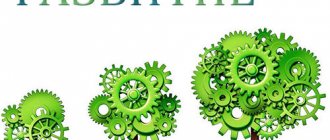Article:
Every child tends to be capricious from time to time.
Sometimes this happens for obvious reasons: tired, nervous, offended someone, faced injustice. But there are entire periods when uncontrollable and intolerable behavior is not limited to one situation, but continues for several months. Disobedience, hysterics, protests, rude speech, refusal to make contact - the list of problems can be endless. In this difficult period, it is difficult to find any logical explanation for what is happening. Those who are familiar with psychology know that age-related crises are to blame for everything.
What it is
Childhood crises are transitional stages from one stable (lytic) life period to another, characterized by a holistic change in the child’s personality, caused by the emergence of psychological new formations. To designate them, Vygotsky introduced the term “normative crises of development.”
There are many different approaches to their definition and classification (Vygotsky, Elkonin, Erikson, Leontiev, Bozhovich, etc.). Despite such diversity, they are all very similar and agree on most key points.
Psychology explains them quite simply. All children grow in leaps and bounds, during which, according to research, the brain begins to actively emit impulse waves. Scientists have yet to find out their nature and significance, but at these moments significant changes occur with mental and physical development.
Physical changes
Just yesterday he was crawling, but today he is already clumsily walking. Just yesterday I couldn’t do without outside help, but today I’m tying my shoelaces and trying to make breakfast for myself. Just yesterday my daughter was an angular, clumsy teenager, and today she has turned into a beautiful, mature girl.
Mental changes
Each age-related crisis period is accompanied by neoplasms. At 1 year - this is autonomous speech, motivating ideas, self-image. At 3 years old - primary independence, building more complex relationships, a new level of self-awareness, volitional regulation of activity. At 7 years old - arbitrariness and indirectness of actions, awareness of one’s own experiences, new social roles. At 13 - an exaggerated sense of adulthood. At 17 - professional and personal self-determination.
Why are these surges called crises? Because they represent a difficult transitional state to a new level - both physically and mentally. This process is not easy not only for parents, but most of all for the child himself. He is afraid of the dramatic changes that are happening to his body and worldview. And in response to them he begins to protest, trying to run away and hide from such a development of events. Hence the uncontrollable behavior.
Periodization
In psychology, there are usually five childhood crises by age:
- 1 year - transition from infancy to early childhood;
- 3 years - transition to preschool age;
- 7 years - mastering school;
- 13 years - adolescence;
- 17 years old is the beginning of early adolescence.
However, this periodization is quite arbitrary. In the works of psychologists, textbooks, and various sources one can find other interpretations of it.
For example, there is an opinion that a separate newborn crisis should include the entire first year of a baby’s life, from birth to standing. In fact, every week there can be called a transition period, characterized by sharp jumps in physical condition.
According to another point of view, the crisis periods of 13 and 17 years should be combined into one - adolescence.
In some sources, the crisis of early adolescence is excluded from this periodization, since a seventeen-year-old person can hardly be called a child in the general sense of the word.
Such discrepancies in periodization should not be scary. Their descriptions are as similar as possible.
Why is it important to know and understand the essence of difficulties?
As stated above, each crisis is associated with certain difficulties, with changes in the emotional and psychological state.
And how a person copes with them depends not only on his future life, but also on how he will survive subsequent periods of crisis.
After all, every time he develops skills and abilities that help him fight their manifestations.
And one moment. The faster a person realizes what he is faced with, the faster the fight against the crisis will begin. If you leave everything to chance, it can drag on for years, although usually with the right approach it goes away in a few months.
Views of psychologists
Many psychologists have made their contribution to the classification and description of childhood age-related crises.
Vygotsky
The foundations for understanding age-related childhood crises were laid by Lev Semyonovich Vygotsky:
- identified lytic (stable) and critical periods of development;
- called the main content of each of them the restructuring of the social situation;
- I believed that at the end of each of them, parents get a completely different child.
For the first time he put forward the idea that each critical period is a driving force for development in physical and personal terms. In this he was fully supported by other psychologists.
Leontyev
Alexey Nikolaevich Leontiev introduced the concept of leading activity (LA). In his opinion, each of the age-related crises is nothing more than a transition to a new VD:
- 1 year - object-tool training (was emotional);
- 3 - plot-role-playing;
- 7 - educational;
- 13 - intimate and personal;
- 17 - educational and professional.
The fact that every age leap is accompanied by a transition from one leading activity to another has become generally accepted. But the opinions of psychologists are divided on what kind of internal dynamics determines adolescence:
- according to Feldstein - socially useful;
- according to Davydov - socially significant;
- according to Belicheva - referentially significant;
- according to Polivanova - design.
According to Leontyev, it is the change in leading activity that is the main sign of each age-related crisis in the development of a child.
Bozovic
Lidiya Ilyinichna Bozhovich introduced the concept of neoplasm. These are the mental and social changes that occur with a child during a crisis period. They determine consciousness, attitude to the environment, interpersonal contacts, internal and external life. They are the generalized result of all mental development at the appropriate stage of life and become the basis for the formation of mental processes during the next crisis.
Neoplasms are formed at the junction of two periods and mark the completion of the previous stage of development and the beginning of the next.
Elkonin
Danil Borisovich Elkonin created his own, based on generally accepted periodization. Its foundation was his identification of two systems in which, according to the psychologist, every child develops:
- “a child is a social object”: development of the mental sphere;
- “child is a social adult”: development of the personal, motivational sphere.
Elkonin divided each stable period designated by Vygotsky into two substages. In the first, the VD is connected to one system, in the second - to another. Transitions between them are crisis leaps forward. This is what its periodization looks like:
Early childhood:
- infancy (up to one year) - crisis of 1 year (minor);
- early age (1-3 years) - crisis of 3 years (major).
Childhood:
- preschool age (4-7) - 7 years (small);
- junior school age (8-11) - 12 years (big).
Adolescence:
- younger adolescence (12-15) - 15 years (small);
- older adolescence (16-17) - 17 years (large).
Thus, for Elkonin, the age crisis of 13 years is divided into two more detailed ones - 12 and 15.
Erickson
Erik Erikson introduced the concept of identity crisis. It lies in the fact that during a problem period the child has to choose between two dilemmas. Depending on the decision made, personality development proceeds in the future either in a positive or negative way. Its periodization:
- 1 year - to trust the world around us or not?
- 3 - to be independent or to experience a constant feeling of shame for what you have done?
- 7 — reveal your initiative and organizational abilities or listen to criticism and remain in the shadows?
- 13 - be self-sufficient or insecure?
- 17 - who am I and what do I want?
According to Erikson, if the wrong path is chosen during a crisis period, this leads to disturbances in personality development.
Errors
There are 4 key mistakes:
- The most important It’s a mistake to ignore the symptoms of a crisis.
Because of this, it can last for many years, during which the life of not only the person himself, but also those around him will worsen.
He may lose his job, friends, etc.
- The second mistake is impulsive, thoughtless actions. Most often it is committed during a midlife crisis. And if the hair dyed orange grows back, then finding a good job and bringing the family back will be extremely problematic.
- The third mistake, like the second, is typical for middle-aged people. Unable to cope with the surging emotions and difficulties, a person begins to abuse alcohol, and sometimes even take drugs. But the situation only gets worse from this.
- And one more mistake . It is usually allowed by older people. We are talking about loneliness, when a person is left alone with his far from pleasant feelings and emotions. On the one hand, I don’t want to burden others with my experiences. On the other hand, a heart-to-heart conversation with one of your family and friends always calms you down, gives you strength and encourages you to move on.
general characteristics
All age-related childhood crises have specific features.
1 year:
- with learning to walk, the available space expands;
- Autonomous speech appears (they express emotions with sounds);
- behavior is determined by impressions, and not by dependence on objects;
- the first awareness of oneself occurs (they recognize themselves in the mirror).
3 years:
- relationships with adults change;
- there is a separation of oneself from others;
- opportunities are realized;
- the need for respect and recognition arises.
7 years:
- you have to learn new rules of school life;
- The operational and technical sphere is developing at an accelerated pace;
- sociocultural experience is acquired;
- educational activities become important;
- self-regulation develops.
Teenage years:
- communication with peers comes to the fore;
- self-awareness develops - an internal sense of oneself as an individual;
- life plans are drawn up that will allow you to live independently in the future;
- self-determination appears - awareness of one’s place in human society;
- reflection, formal-logical intelligence and hypothetico-deductive thinking are formed.
It must be borne in mind that even among psychologists, periodization is quite arbitrary. You cannot take this age too literally: a crisis of 3 years does not mean at all that it will begin on your birthday and will last exactly 12 months. This criterion is quite individual. For some, the jump occurs earlier, for others later. And they can also last differently: for some, everything ends after 3 months, while others have to endure for six months or longer.
Main symptoms
Age-related developmental crises are characterized by certain symptoms.
1 year:
- loud crying without tears;
- sudden movements: waving their arms, stomping their feet, shaking their heads, swinging to strike;
- excessively lively facial expressions: frowning eyebrows, pursing lips tightly, narrowing eyes;
- demanding intonations;
- dangerous curiosity when drawn to everything forbidden;
- restlessness;
- protests against the actions of adults (tearing off clothes) and the usual routine (refusing to eat);
- importunity.
3 years:
- negativism;
- obstinacy;
- stubbornness;
- riot;
- despotism;
- depreciation;
- self-will.
In addition to the above “seven stars”:
- distance from parents;
- pathological, inexplicable greed;
- harmfulness;
- jealousy;
- unreasonable aggression: they can bite, scratch, fight.
7 years:
- do not obey;
- they want to be adults: they imitate someone older, refuse to play with those who are younger;
- do not accept criticism;
- deliberately offend others.
Teenage crisis:
- hostility, conflict;
- gross violations of discipline, rules, prohibitions;
- desire for loneliness and isolation, replacement of real communication with virtual communication;
- hot temper, impulsiveness;
- decline in school performance;
- increased sensitivity to criticism.
There are also common points for all age leaps: disobedience, protests and even riots against boundaries and restrictions, closedness, loss of authority of adults and trust in them, sudden changes in mood, irritability, aggression.
What causes age-related difficulties?
In short, 3 groups of factors contribute to the development of age-related maturity crises:
- Physiological. A person faces deterioration in physical health. Of course, at 18-30 years old this is not so noticeable.
But then the symptoms will become brighter and brighter. As one gets older, one loses the ability to conduct everyday life and even take care of oneself.
- Psychological . There is a revaluation of values. Moreover, it happens in every crisis period, regardless of age.
- Social . A person asks questions about whether he has completed all the tasks assigned to him, whether he has built a career, started a family, etc. If the answer is no, depression cannot be avoided.
Other reasons and factors can provoke the onset of a crisis. All ages have their own.
Overcoming crises
To ease the worries of parents, psychologists describe in detail the features of interaction with a child during periods of crisis by year:
1 year:
- comprehensively develop;
- ensure household safety;
- teach independence;
- practice categorical prohibitions using the words “must” and “impossible.”
It is strongly not recommended at this age to wean the mother, go to work, and send the baby to kindergarten until the crisis period is over.
3 years:
- be able to switch the child’s attention;
- scold only for some specific action done here and now;
- do not operate with complex categories such as conscience, honor, duty;
- avoid “shortcuts”;
- do not force help.
7 years:
- gradually replace gaming activities with educational ones;
- provide the right to choose;
- correctly point out mistakes made;
- help with homework;
- constantly be in touch with the teacher;
- do not criticize adults in their presence;
- encourage communication with peers;
- do not compare with others;
- help in solving school problems.
Teenage years:
- look for compromises and “common ground” in all situations;
- involve in the discussion of family plans, give them the opportunity to speak out, take their opinion into account;
- maintain friendly, trusting relationships;
- be genuinely interested in their hobbies;
- delegate a number of responsibilities as an expression of trust;
- do not demand immediate fulfillment of the request: give time to think;
- control your social circle.
Despite the individual features of raising children during periods of age-related crises, there are a number of common points:
- Pay more attention to them, spend a lot of time with them.
- Change your environment more often: travel, go hiking, take part in events, walk to different places.
- Don't punish physically.
- Don’t raise your voice, don’t start open conflicts, don’t get into altercations.
- Each time, expand the circle of their rights, give them more independence, but gradually.
- Don't be led.
- Ensure a clear daily routine with mandatory physical activity.
- Discuss problem situations and draw conclusions.
- Explain to all other family members that the education system should be uniform.
- Demonstrate correct behavior by example.
Parents must take into account all these points in order not to escalate the situation and help the child survive all the crises of growing up with minimal losses.










